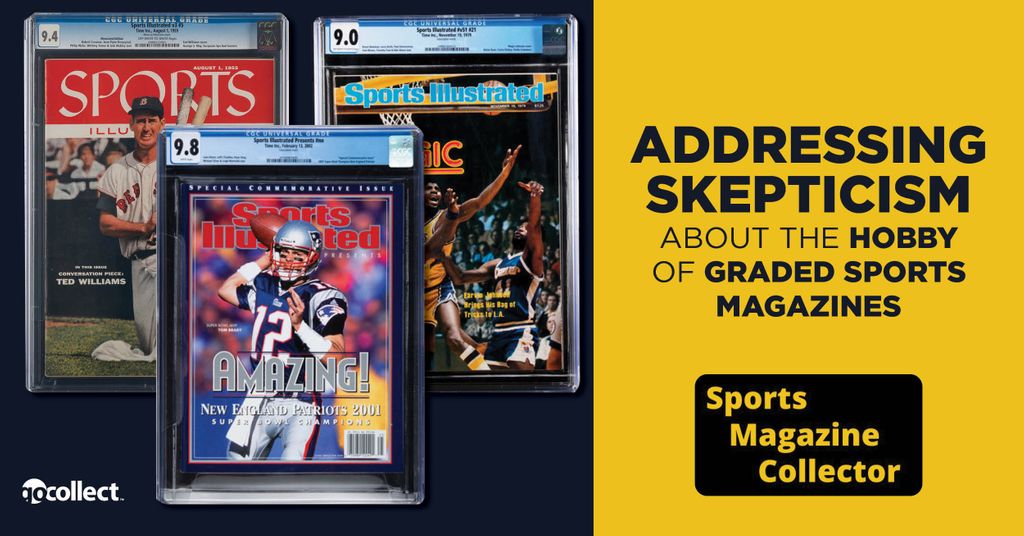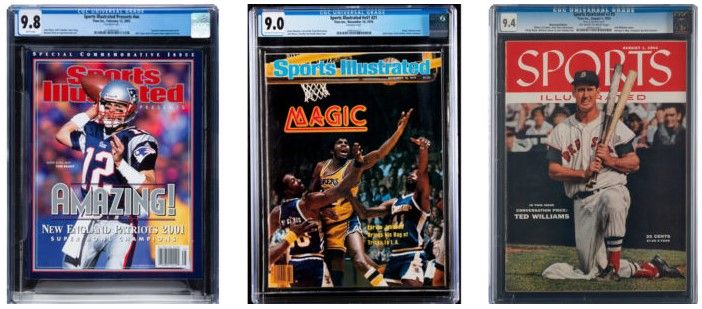
Since the sports collectibles boom that has taken place as a result of the pandemic, with it has come a rise in those simply looking to make a quick buck. Hobbies that were once dominated by truly passionate collectors have been bombarded with newbies identifying themselves as “investors”. And while there is nothing wrong with selling or trading these various items, the climate has left those with good intentions ultra-skeptical anytime something new enters the fray.
Do graded sports magazines deserve a legitimate seat at the table of sports collectibles? Or are they nothing more than a money grab from “investors” looking for the next big thing?
To fully consider the answer to these questions, let’s first ask ourselves one other. What makes a collectable, collectible? (Please don’t waste as much time looking up the proper use of those two words as I did!)

Graded sports magazines have recently been growing in popularity.
Graded Sports Magazines Check a Lot of Boxes
Let’s think about some of the most popular collectible items. Comic books, trading cards, coins, vinyl records, video games, and the list goes on. What is at the root of anyone wanting to collect such things? First off, most of them are visually appealing. Secondly, many evoke nostalgia or provide some sort of meaningfulness to our personal interests. Third—and this is where value can come into play—there is often a component of rarity.
Graded sports magazines check these boxes. There is no doubt that many of the cover photos with star athletes are very visually appealing. Additionally, the nostalgia for these items—especially Sports Illustrated—is through the roof for anyone who grew up a sports fan. And third, it is becoming quite clear that high-grade, newsstand editions of sports magazines (meaning it was purchased straight from the rack and never had a mailing label) are highly scarce and often very difficult to find.
Add in the fact that Sports Illustrated (the gold standard of sports magazines) is a reputable and adored brand going back for the last 70 years, and it is clear that there is significant legitimacy to this hobby. But with that being said, let’s address the most common knocks I hear from collectors who aren’t yet fully educated about the hobby of graded sports magazines.
“Magazines Are Meant to be Read”
A common jab I hear about the idea of grading video games is that the owner can no longer use the item for what it was initially intended for – to be played. This is a fair qualm and it is very similar to what I often hear about graded sports magazines. If you grade a magazine, how can you read it?
Well, you can’t. But in reality…do we care?
Like thousands, I had a subscription to Sports Illustrated growing up. I still have huge stacks of subscription issues from 20 years ago sitting on a bookshelf and in storage tubs. Do you know how many times I’ve pulled those out to look through them? Maybe once. And even then, I probably only flipped through a couple magazines out of the several hundred that I still own. The truth is, those subscription issues are just collecting dust. I’ve kept them because, well, I guess I’m a hoarder and I hate the thought of pitching all that sports history in the trash. But the truth is, I’m probably never going to go back and truly read them.
The covers, on the other hand….man, those things are gorgeous. If I could display those in my living room or home office and stare at them every day, I would. Just like I already do with that 1998 Starline Kobe Bryant poster that I bought from the scholastic book fair for 99 cents. Enter encapsulation. Grading sports magazines gives you that opportunity to both preserve and show off your favorite covers for display rather than allowing them to lay for years as stagnant stacks of termite snacks.
And here’s the great thing. If you really, truly, actually want to go back and read these magazines...you can easily do so. Sports Illustrated has all of its issues available online electronically. In addition, physical copies of subscription issues can be had in most cases for less than $10 apiece. Remember, it’s the newsstand copies that are difficult to find and that fetch high premiums. Consider this. Wayne Gretzky’s first Sports Illustrated cover from 1981 currently holds the record for the highest sports magazine sale of all time. A copy graded at CGC 9.4 sold in February 2022 for $30,000. A simple search that I conducted just now on eBay shows that even that magazine, the highest-selling of all time, can be purchased as a subscription copy for as low as $25. Read away, my Reading Rainbow warriors.
A subscription copy of Wayne Gretzky’s first Sports Illustrated cover from 1981.
“Sports Magazines Aren’t Rare”
This is a common conception that is actually largely true. Sports Illustrated magazines, in and of themselves, are most definitely not rare at all. As I’ve shared before, Sports Illustrated at one time had over 3 million subscribers. So if there were 3 million copies of these magazines being delivered to doorsteps each week, that doesn’t exactly equate to rarity.
But once again, the newsstand copies that were purchased straight from the rack and never possessed a mailing label are incredibly scarce. Let’s take for example the “big 3” of Sports Illustrated magazines. Mickey Mantle’s first cover (1956), Muhammad Ali’s first cover (1963), and Michael Jordan’s first cover (1983). These are arguably the three most collectible and potentially valuable issues in the history of Sports Illustrated and here are the population counts for the number of newsstand copies that have been graded by CGC: Mantle – 37; Ali – 20; Jordan – 88.
And this applies to more modern issues as well. Tiger Woods’ first SI cover from 1996 has been graded a total of 62 times as a newsstand. Tom Brady’s first SI cover from 2002—76 times. Steph Curry’s first cover from 2013—26 times. Those are extremely low numbers for such collectible items, especially when compared to key comics and sports cards.

Muhammad Ali’s first Sports Illustrated cover from 1963. As of today, only 20 newsstand copies have been graded by CGC.
“Pop Counts Are Only Low Because This is so New”
Yeah, okay, there haven’t been many copies graded. That’s because CGC just started grading them! Right? Wrong. CGC is a company primarily known for grading comic books, something that they began doing in the year 2000 according to the “About CGC” webpage. On the very same page, CGC states “In 2009, CGC introduced grading and encapsulation for magazines, starting with Sports Illustrated and Playboy and expanding to most of today’s best-known titles.” Therefore, magazine grading has been going on for 13 years. And if you dig into the data, you will see that more and more SI issues have been getting submitted to CGC each year.
Now, is grading sports magazines much newer than sports cards? Yes. It is newer than grading comics? Yes. Is it likely that pop counts will continue to rise as the hobby grows in popularity? Of course. But it is a false pretense to assume that these newsstand Sports Illustrated copies only appear rare due to the infancy of their grading. Go try to track down a raw newsstand copy of Mantle, Ali, or Jordan’s first cover and let me know how that goes for you. Because I can count on one hand how many I’ve seen for sale in the past year. The fact that so few have been graded in 13 years is highly telling. These newsstand issues can be white whales and that’s what makes the hunt so fun!
Want more Graded Sports Magazine coverage?
-
THE TOP 10 HIGHEST SPORTS MAGAZINE SALES FROM AUGUST/SEPTEMBER 2022
-
SPORTS ILLUSTRATED: THE MOST VALUABLE COVERS
-
COMICS + SPORTS CARDS = SPORTS ILLUSTRATED MAGAZINES?






